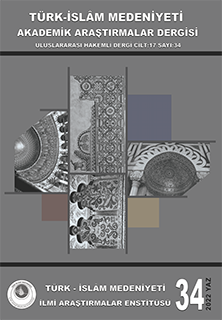The Approach of the Founder Leaders of the Turkish Independence War to the Implementations Regarding to the National Sovereignty and the Caliphate
Keywords:
The abolishment of the Sultanate, The proclamation of the Turkish Republic, The abolition of the Caliphate, Institution reforms, DemocracyAbstract
Upon the invasions which began after the Ottoman Empire was defeated in the First World War, Turkish Independence Movement came out. On one side local preparations for liberation against the invasions were made in the Anatolia, on the other side a part of the military command echelon began to look for the ways of military liberation. Mustafa Kemal Pasha, who wanted initially to put the diplomacy into effect, became the natural leader of the ones who sided with the independence movement in a short time, and the commanders Mr. Rauf (Orbay), Gn. Kâzım Karabekir, Gn. Ali Fuat (Cebesoy) and Gn. Refet (Bele) adopted his leadership. However, different points of view started to arise in the process of the political structuring which began with the Lausanne Peace Conference after the military phase of the independence war succeeded. It is seen that the leaders of the independence war approached with different points of view to the political reforms like the declaration of Ankara as the capital city, the abolishment of the sultanate, the proclamation of the Turkish Republic, the abolition of the Caliphate. The important part of the differences was related to the course pursued rather than the principle of the implementations. While Mustafa Kemal Pasha was seemed to be rather hasty because of his concerns about the structural reforms, the other members of the founder leaders treated sensitively in the application of the democratic methods.
References
AKKOR, M., 2012, “Dini Bir Müessesenin Sonu: Hilafet’in İlgası”, History Studies, Volume: IV, Issue: 1.
ATATÜRK, M. K., 1989, “Nutuk- Söylev 1920-1927”, C: II, Ankara. AVCIOĞLU, D., 1978, “Milli Kurtuluş Tarihi 1838’den 1995’e”, C: IV, İstanbul. AYDEMİR, Ş. S., 2010, “İkinci Adam 1884-1938”, C: I, İstanbul.
BERKES, N., 1978, “Türkiye’de Çağdaşlaşma”, İstanbul.
BİL, H., t.s., “Atatürk’ün Sofrasında”, Ekicigil Yayınları, y.s.
CEBESOY, A. F., 2007, “Siyasi Hatıralar Büyük Zaferden Lozan’a Lozan’dan Cumhuriyete”, C: I-II, İstanbul.
İNAN, A., 1996, “Gazi Mustafa Kemal Atatürk’ün 1923 Eskişehir- İzmit Konuşmaları”, Ankara.
İNÖNÜ, İ., 2009, “Hatıralar”, Haz. Sabahattin Selek, Ankara.
İZ, M., 1990, “Yılların İzi”, İstanbul.
KANDEMİR, F., 1965, “Hatıraları ve Söyleyemedikleri ile Rauf Orbay”, Sinan Matbaası, İstanbul.
KARABEKİR, K., 2009, “Günlükler (1906- 1948)”, C: II, İstanbul.
KAYA, H., 2010, “Refet Bele Askerȋ ve Siyasi Hayatı 1881-1963”, İstanbul.
KOÇ, N., 2012, “Mustafa Kemal (Atatürk) ve Ali Fethi (Okyar)’nin Faaliyetleri Işığında Osmanlı Devleti’nde Yaşanan Siyasi gelişmeler”, Türk-İslam Medeniyeti Akademik Araştırmalar Dergisi, C: VII, sayı: 14.
----------, 2013, “Milli Mücadelenin Başlarındaki Gelişmelerin Hatıralar Çerçevesinde Değerlendirilmesi”, The Journal of Academic Social Science Studies, C: VI, Sayı: 3.
NUR, R., 2010, “Cumhuriyet Devrinin Perde Arkası (1923- 1933)”, İstanbul.
NUR, R.- GREW, J. C., 2013, “Lozan Barış Konferansının Perde Arkası (1922- 1923)”,İstanbul.
ORTAYLI, İ., 2013, “Yakın Tarihin Gerçekleri”, İstanbul.
SATAN, A., 2013, “Türk ve İngiliz Belgelerinde Halifeliğin Kaldırılması”, İstanbul.
SOYAK, H. R., 2010, “Atatürk’ten Hatıralar”, İstanbul.
STREİT, C. K., 2012, “Bilinmeyen Türkler”, Haz. Heath W. Lowry, İstanbul. ŞİMŞİR, B. N., 1974, “Halifesiz 50 Yıl”, Cumhuriyet Gazetesi, 4 Nisan.
----------, 1981, “Dış Basında Atatürk ve Türk Devrimi 1922-1924”, C: I, Ankara.
TBMM Zabıt Ceridesi, İ: 130, C: I, 1.11.1338. TBMM Zabıt Ceridesi, İ: 30, C: I, 2.10.1339. TBMM Zabıt Ceridesi, İ: 31, C: I, 3.10.1339. TBMM Zabıt Ceridesi, İ: 33, C: I, 8.10.1339. TBMM Zabıt Ceridesi, İ: 2, C: I, 3.3.1340. Tevhid-i Efkâr, 29 Teşrinievvel 1341.
Tevhid-i Efkâr, 30 Teşrinievvel 1341.
TURAN, N. S., 2008, “Osmanlı Hilafetinin 19. Yüzyılda Zorlu Sınavı: II. Meşrutiyet’e Giden Süreçte ve Sonrasında Makam-ı Hilafet”, İ.Ü. Siyasal Bilgiler Fakültesi Dergisi, No: 38.
VILLALTA, J. B., 1991, “Atatürk”, İspanyolca’dan İngilizce’ye Çev. William Campbell, Ankara.
ZÜRCHER, E. J., 1996, “Modernleşen Türkiye’nin Tarihi”, İstanbul.
Downloads
Published
How to Cite
Issue
Section
License

This work is licensed under a Creative Commons Attribution-NonCommercial 4.0 International License.







